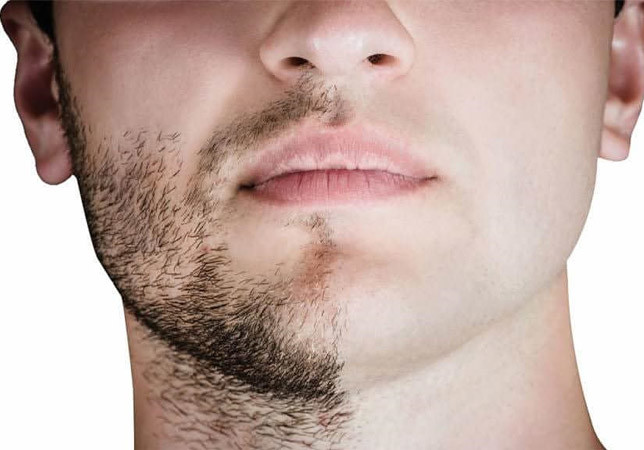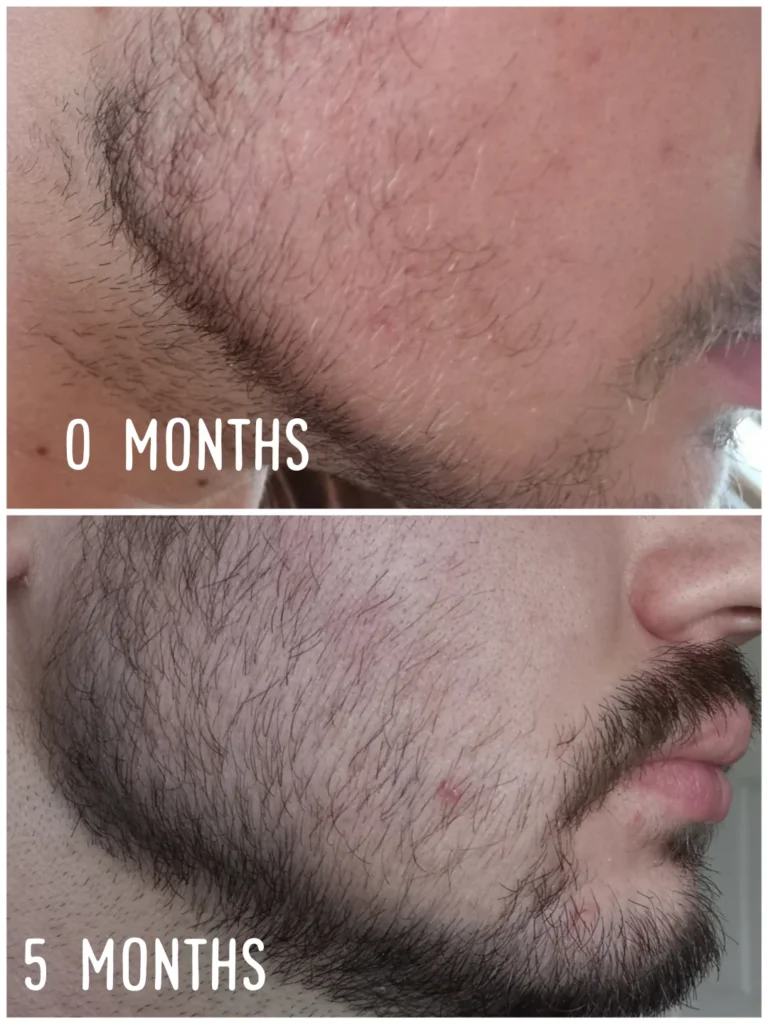Get personalized Consultation!
Beard & Moustache Transplant
At Vida Skin and Hair Transplant Clinic, we specialize in providing high-quality beard and moustache transplantation procedures. We understand that a full, well-groomed beard and moustache can significantly enhance a man’s appearance and boost his self-confidence. With our expertise and state-of-the-art techniques, we aim to help our patients achieve their desired facial hair goals. In this article, we will provide you with a step-by-step insight into the beard and moustache transplantation process, along with information on factors such as the number of grafts, hair growth, recovery, and more.

How many grafts should be transplanted?
The number of grafts required for a successful beard and moustache transplant varies from person to person, depending on factors such as the individual’s desired density, facial structure, and available donor hair.
During a consultation at Vida Skin and Hair Transplant Clinic, our experienced medical professionals will assess your unique needs and determine the appropriate number of grafts required for your desired outcome. This personalized approach ensures that each patient receives a tailored treatment plan that suits their specific requirements.
What are the steps and stages for a beard and moustache transplant?

A beard and moustache transplant typically involves the following steps and stages:
Consultation:
During the initial consultation, our medical professionals will evaluate your facial hair growth pattern, discuss your desired beard and moustache style, and examine the density of your donor hair. They will also provide you with detailed information on the transplantation process, potential risks, and expected outcomes. This consultation is crucial for establishing a clear understanding between the patient and the medical team.
Donor Hair Extraction
In order to perform the transplant, healthy hair follicles need to be harvested from a suitable donor area. The donor area is typically the back of the scalp, where the hair follicles are genetically resistant to balding. Follicular Unit Extraction (FUE) is a popular technique used to extract individual hair follicles from the donor area, minimizing scarring and ensuring natural-looking results.
Graft Preparation:
Once the hair follicles have been extracted, they are carefully dissected and prepared for transplantation. The grafts, consisting of one to four hair follicles each, are sorted based on their quality and suitability for the transplant.
Recipient Site Preparation:
The recipient site, which refers to the area where the hair will be transplanted, is prepared by making tiny incisions or punctures. The medical team pays close attention to the angle, direction, and density of the recipient site to ensure a natural-looking and aesthetically pleasing outcome.
Graft Placement:
The prepared grafts are then meticulously placed into the recipient sites, following the patient’s desired beard and moustache pattern. The experienced medical team at Vida Skin and Hair Transplant Clinic ensures that the grafts are implanted at the correct depth and angle to promote optimal hair growth.
What to Expect During Beard & Moustache Transplantation
Undergoing a beard and moustache transplant is a comfortable and relatively painless procedure.
At Vida Skin and Hair Transplant Clinic, we prioritize our patients’ comfort and use local anesthesia during the transplantation process to ensure a painless experience.
The procedure is typically performed on an outpatient basis, allowing patients to return home on the same day.
Will the hair growth of the beard be the same as on the scalp?
The hair growth of the beard after a transplant may differ from the hair growth on the scalp. Transplanted hair often exhibits slower growth compared to native hair. It is common for the transplanted hair to have a slower initial growth phase, with visible results becoming more apparent after several months. However, once the transplanted hair has fully grown, it can be styled and groomed just like natural beard and moustache hair.

How is the hair growth after the transplant?
After a beard and moustache transplant, patients can expect their transplanted hair to follow a normal hair growth cycle.
Initially, the transplanted hair may shed as part of the natural process, but this is perfectly normal and temporary.
Subsequently, new hair growth will gradually occur, and full results can usually be seen within one year.
It is important to have patience during the post-transplant period, as the final outcome may take some time to become fully visible.
When can you shave the beard after the operation?
Patients are typically advised to avoid shaving the transplanted beard and moustache for at least ten days post-transplantation.
This allows the transplanted hair follicles to properly settle and establish themselves in their new location.
After the initial ten-day period, patients can resume their regular shaving routine, taking care to be gentle around the newly transplanted hair.
Tips for the patient after the beard transplant
To ensure the best possible results and promote proper healing after a beard and moustache transplant, it is essential for the patient to follow these post-operative tips:
- Avoid touching or scratching the transplanted area.
- Refrain from engaging in strenuous physical activities or exercises for at least a week post-transplantation.
- Follow all post-operative instructions provided by the medical team at Vida Skin and Hair Transplant Clinic.
- Avoid excessive exposure to direct sunlight and protect the transplanted area from harmful UV rays.
- Attend all scheduled follow-up appointments to allow the medical team to monitor the progress of hair growth and recommend any necessary adjustments to the post-operative care plan.
Benefits and Risks of Beard & Moustache Transplantation
Beard and moustache transplantation offers numerous benefits for individuals who desire a fuller facial hair appearance. Some of the benefits include:
- Enhanced self-confidence and improved self-image.
- Ability to achieve desired beard and moustache styles.
- Restoration of facial hair in areas affected by scarring or hair loss.
- Long-lasting and natural-looking results.
However, as with any medical procedure, there are inherent risks involved in beard and moustache transplantation. These risks may include:
- Infection or inflammation at the transplant site.
- Scarring or unnatural hair growth patterns.
- Temporary or permanent hair loss in the donor or recipient areas.
- Bleeding or bruising around the transplant site.
It is crucial to consult with a qualified and experienced medical professional, like the experts at Vida Skin and Hair Transplant Clinic, to assess the benefits, risks, and suitability of a beard and moustache transplant based on individual circumstances.
Preparing for Beard & Moustache Transplantation
To ensure a smooth and successful beard and moustache transplant, patients are advised to follow these pre-operative guidelines:
- Avoid smoking and alcohol consumption for a few weeks leading up to the procedure, as these factors can negatively impact the healing process.
- Discontinue the use of blood-thinning medications or supplements, as they can increase the risk of bleeding during the transplant.
- Communicate openly with the medical team, providing accurate information about medical history, medications, and allergies.
- Follow any pre-operative instructions provided by the medical team at Vida Skin and Hair Transplant Clinic, such as avoiding food or drink for a specific period of time before the procedure.
Aftercare and Recovery from Beard & Moustache Transplantation
Proper aftercare is essential for facilitating the healing process and optimizing the results of a beard and moustache transplant. After the procedure, patients can expect the following:
- Mild redness and swelling in the transplant area, which typically resolves within a few days.
- The formation of tiny crusts or scabs around the transplanted hair, which will naturally fall off over time.
- Post-operative care instructions, including the use of prescribed medications, gentle cleansing techniques, and avoiding certain activities or products.
Following the provided aftercare guidelines and attending follow-up appointments at Vida Skin and Hair Transplant Clinic will help ensure proper healing and the best possible outcome from the beard and moustache transplant.
Do's and Don'ts
To support the healing process and achieve optimal results from a beard and moustache transplant, here are a few important do’s and don’ts:
- Do follow the post-operative care instructions provided by the medical team.
- Do protect the transplanted area from excessive sun exposure.
- Do attend all scheduled follow-up appointments.
- Don’t scratch or pick at the transplanted area.
- Don’t engage in strenuous exercises or activities for at least a week after the procedure.
- Don’t shave the transplanted beard and moustache for at least ten days post-transplantation.
By adhering to these guidelines, patients can ensure a smooth recovery and enjoy the full benefits of their beard and moustache transplant.
At Vida Skin and Hair Transplant Clinic, we are dedicated to providing exceptional beard and moustache transplantation services.
With our expertise and commitment to patient satisfaction, we strive to help individuals achieve their desired facial hair goals.
If you are considering a beard and moustache transplant, schedule a consultation with our experienced medical team and take the first step towards enhancing your appearance and boosting your confidence.
Frequently Asked Questions!
A Beard & Moustache Transplant is a cosmetic procedure where hair follicles are transplanted to the face to enhance beard and moustache growth. This is typically done by extracting hair follicles from donor areas (often the back of the scalp) and implanting them into areas with sparse or no facial hair.
Patients usually start noticing initial signs of hair growth within a few weeks to a month after the transplant. However, full and noticeable results may take several months as the transplanted hair follicles go through a natural growth cycle.
Yes, a Beard & Moustache Transplant provides a permanent solution. The transplanted hair follicles are typically resistant to the hormones that cause hair loss, offering a long-term and natural-looking enhancement to facial hair.
Recovery varies from person to person, but most individuals can resume their normal activities within a week. Initially, there might be some redness and swelling, which subsides over time. It’s crucial to follow post-operative care instructions provided by the surgeon to ensure optimal healing.
As with any surgical procedure, there are potential risks and side effects, though they are generally minimal. These may include infection, scarring, or temporary shock loss (shedding of transplanted hair). However, these issues are rare, and selecting a skilled and experienced surgeon can significantly minimize the risks associated with the procedure.
Ideal candidates for a Beard & Moustache Transplant are individuals with sparse facial hair, limited beard growth, or uneven distribution. A consultation with a qualified surgeon is necessary to assess individual candidacy based on factors such as donor hair availability and overall health.
The duration of a Beard & Moustache Transplant can vary, but it typically takes several hours. The exact time depends on factors such as the extent of the transplantation and the method used. It’s advisable for patients to plan for a day off for the procedure and a brief recovery period.
While a Beard & Moustache Transplant is a popular and effective option, alternatives include topical treatments and medications designed to promote hair growth. However, these alternatives may not provide the same long-term and natural results as a transplant, and individual responses can vary.
Yes, patients can discuss and collaborate with the surgeon to determine the desired beard and moustache style during the consultation. The surgeon will consider factors such as facial structure and hair characteristics to achieve a natural and aesthetically pleasing result.
The procedure is typically performed under local anesthesia, ensuring that patients are comfortable and do not feel pain during the transplant. Post-operative discomfort is minimal and can be managed with prescribed medications. Patients should follow the provided guidelines for a smooth and pain-free recovery.